At first, I was tempted to call “Mulan vs Tenet” the biggest battle of the streaming wars. Each weekend in September, we’ve eagerly awaited answers to the hottest questions in film: Will Tenet save theaters? Will Mulan blow up the model? Who is making more money? Who is WINNING?!?!?
It turns out that the answer to the first two questions is probably no. As for the third and fourth, well, that’s tricky to answer. But since it’s the logical follow-up to my article on Monday, I’ll do my best.
But I wouldn’t call this a battle. If anything it’s a “skirmish” on one end of the larger distribution battle. (The sort of way that Pickett’s Charge was one tactical engagement in the larger Battle of Gettysburg.) Just because it is a skirmish doesn’t mean it isn’t important. Skirmishes are what win or lose battles! (For want of a nail…)
So after three weeks of data, let’s analyze what we know. Here’s the outline of today’s article:
– First, two lessons on data that set the terms of the debate.
– Second, an analysis of what we know about each film, including US box office, International box office, and PVOD sales to date.
– Third, thoughts on each film’s revenue potential after these initial windows.
– Fourth, a comparison between the two films and declaring a winner.
Kidding! I won’t do that last part because I don’t know the answer. Moreover, I won’t draw giant conclusions about what this means for the future of film. Because frankly two films won’t fundamentally change the landscape. But I’ll explain that point in future articles. For now, the performance of these films to date.
(Also, I found that I was linking to a lot of my articles explaining the business of film. To keep this article clean and not polluted with links, I put a “reading list” at the bottom.)
Bottom Line, Up Front
– Comparing the box office of Tenet to PVOD of Mulan is comparing two different windows to each other. That isn’t apples to apples.
– That said, we can’t know the future value of either film because both “inputs” are “n of 1” meaning so unique that we can’t build a model.
– Tenet will likely gross $325-350 in global box office.
– Mulan will likely gross $70-100 million in global box office.
– Mulan will end up with likely $155 million in global PVOD (with a big range of $105-$270 million.)
– As for lifetime earnings? No one really knows, because there aren’t good comps to make accurate estimates.
Two Data Lessons: Apples to Apples and “n of 1”
My primary job on this site, as I see it, is to explain the entertainment business. You can find lots of places on the internet opining about the entertainment business; I’m trying to teach you why it works the way it does. And in the “Mulan v Tenet” debate, I see two major mistakes being made.
First, Apples-To-Apples
That’s my simple term for comparing like-to-like. In some ways, statistics/data analysis/science is essentially the quest for comparing things like-to-like as much as possible. That way you can isolate the the true drivers of causality. (That’s why random controlled trials are random and controlled.)
Here’s a simple example from last week: folks saw that 7 Park’s data was much larger than peer analytics companies for Mulan’s debut. The key, though, was that they were measuring eight days of data, and not just the opening weekend. They were also measuring the percentage of folks who watched Mulan who were active users, not all subscribers. Once you accounted for this, their math (1.5 million subscribers), was close to other estimates (1 million at the low end for Antenna and 1.1 from Samba TV). Comparing things apples-to-apples solved the problem.
In “Mulan v Tenet”, the key question/claim at the center of the debate misunderstands this notion. Consider these major windows of movie revenue:
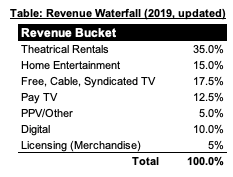
The question I’ve seen written and been asked repeated is, “Is Mulan making more than Tenet?” We could reframe it based on the windows in question. Basically, “Is Mulan making more money in PVOD than Tenet in domestic box office?” That would look like this:

But this isn’t the right question. It’s comparing apples-to-hammers. (A Chuck Klosterman phrase.) Look:

This framing really sets the terms of debate better, in my opinion. Even after Tenet leaves theaters, it can go to US domestic TVOD and home entertainment. So even if the answer to the current question is, “Yes, Mulan has likely made more in PVOD than Tenet at the domestic box office,” the question doesn’t make sense.
(Since PVOD wasn’t a window when I first made this table, I added it above. And I summarized all digital/streaming the “pay windows” to show the timeline better.)
Really the question is, who will make more domestic revenue? So we should fill in this whole chart, accounting for blacked out windows:

And we can see that two big chunks of revenue for that are the same: who will make more in Pay 1, Pay 2 and library distribution? (That means all the future revenue implied by streaming (like Netflix), airing on premium channels (like HBO), cable (like TNT) and other places. Now that question is tricky because of our next data point.)
“n” of 1
I was inspired by the “n” of 1 after reading earlier this year an article in the Economist about the rise of “n” of 1 medicine. “n” is statistics jargon for sample size. If you poll 3,000 folks about the Presidency, your “n” is 3,000. If your sample size is all Americans, that’s a sample (population technically) of 300 million. “n” of 1 medicine is referring to treatments designed for one individual with a unique life-threatening condition. It means the “sample size” is so unique it’s a category by itself.
This applies to box office and film revenue analysis. When we make forecasts based on opening weekend performance, we can do that because movies are similar and we can account for the differences to compare things apples-to-apples. Hence, we use Marvel films to forecast how much money films based on superheroes will make, while accounting for the time of year of the release and various other factors. (Scott Mendelson at Forbes is my favorite analyst at this.)
Once we have box office, we can use its results to forecast all the other windows a feature film is sold into. That’s how my film forecasting model works. It’s a fairly accurate system. We can also do it for PVOD, TVOD, streaming, TV and any revenue stream. Once we have an input, we can derive the rest.
The challenge for both Mulan and Tenet is they are unprecedented. They are without comps in the United States because: 1. No other blockbuster film has released during a pandemic that closed 70% of theaters and 2. No other film released to Disney+ exclusively for a one-time $30 payment.
Because of this, making any forecasts about profitability is perilous. Or should I say, highly uncertain. Meaning, while I know what Mulan did in PVOD—see Monday—I’m much more uncertain about what this means for future windows. Conversely, while I know how well Tenet is doing, I don’t know what that means for future revenue streams, since Tenet is only available in 70% of US markets, that account for about 40% ticket sales.
So let’s start with what we do know.
The Data: International and US Box Office, Mulan PVOD and Forecasts
The easiest data to find is domestic and international box office. Since Tenet has been out a bit longer, it’s getting easier to see what its final total will be. So I’ve included the likely final box office total ranges offered by Scott Mendelson.

Are those numbers good or bad? Well, we’re in the middle of a pandemic, so who knows? As Mendelson makes the case, for an original material sci-fi live action film, Tenet is doing really well!
Meanwhile, even the ranges on Tenet are fairly uncertain. I put $350 million as the likely ceiling, but if New York and California reopen theaters, there could be give it a late boost (and stronger “legs”) as folks go to see it. Or not! A recovery that happens quickly is also unlikely so it could stay middling.
Meanwhile, we know from Monday about how well Mulan is doing on PVOD.
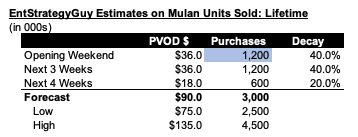
The wildcard of the Mulan PVOD numbers is the fact that Mulan wasn’t just PVOD in the United States, but globally where Disney+ is available. My analysis from Monday focused on US analytics firms since there aren’t a lot of estimates for global performance. It turns out Mulan was released in every Disney+ territory but France and India, which includes these territories:

You’ll note it’s also cheaper in dollar terms in other territories. Time to go to the comps. What I did was find the last five Disney live-action remakes, pull down their box office by territory, and use that as a comp for demand:

The way to read this chart is that the “Disney+ territories that have Mulan” tend to account for 43-75% of the box office of the United States box office. Great! That becomes our tool to forecast PVOD revenue in those other territories. My low will be 40% (slightly lower than the Jungle Book comp) and I made a high of 100% based on Scott Mendelson’s back-of-the-envelope estimate. I consider that the far outlier, but with this much uncertainty that’s okay. Here’s the results:

Of course, I had high case and low case forecasts from Monday, which we could combine. The worry with our estimates now is that we’re making estimates on estimates, which doubles the uncertainty. Which you’ll see in how big our range is getting:

What do we know? We have estimates for how Tenet and Mulan both did in their opening “windows”, one of which was PVOD/theatrical, and one which was theatrical only.
What don’t we know? What comes next.
The Comparison: Mulan v Tenet
Here’s a rough look at the current revenue of both Mulan and Tenet. As in how much each film has brought their studios as of this (rough) moment, roughly through their first month of releases:
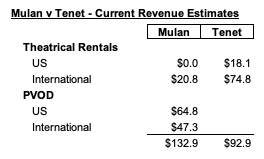
To answer the question I said you shouldn’t ask up above, yes Mulan globally has made more money than Tenet as of this moment. Crucially, the presumed 90% net take beats the 50% domestic/35% international split of theatrical. (Though I think that Disney’s split with PVOD partners like Apple, and Amazon may actually be lower than 90%, but don’t know for sure.) Here’s the look at the question I said we should ask:
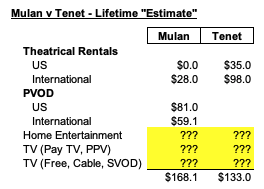
I love this look because it clarifies how much we don’t know. Which is frankly how much Tenet will make on TVOD/DVD, how much Mulan will make in home entertainment, how much more Tenet can make by going to premium cable, and how much both will make in streaming.
Why not try to estimate it?
Because I don’t believe the Tenet or Mulan numbers are good comps for forecasting.
If Tenet’s US box office is depressed because of Covid-19, then it’s home entertainment could make as much as Trolls: World Tour or Mulan at home. Meaning it could have as large a window as Mulan had since 60% of theatrical attendees couldn’t see it. It’s rumored that Mulan will go wide on TVOD (including iTunes, Amazon and maybe even Pay-Per-View), but I don’t know if that viewership has already been cannibalized by this PVOD experiment. If it hasn’t, it could add 33% more revenue as Trolls: World Tour did when it went cheaper on TVOD in July.
Meanwhile, Tenet will eventually be on HBO and likely HBO Max. But Mulan will stay on Disney+ exclusively? Could I calculate that exclusivity value? Nope. Because I still don’t know enough about Disney subscribers to conclude that this PVOD experiment drove subscribers or that Mulan will have good replay value on the platform. (Unlike Netflix, who we have multiple years of US-only data to parse.)
This is the “n of 1” problem I discussed above. There are so many conflicting variables that my usual methods of forecasting are out the window. Same for the studios. They’ll basically have to collect the revenue and see what shakes out.
Thus, at $35 million dollars difference between the two, I’m calling this a push. It’s as likely Tenet makes more money for Warner Bros. as it is Mulan makes more money for Disney.
In short, we’ll never really know who “won” this skirmish since our numbers are close enough to call it a draw. I’d add, using one proxy for demand, Google Trends, it looks like Mulan peaked higher, but Tenet may last longer.
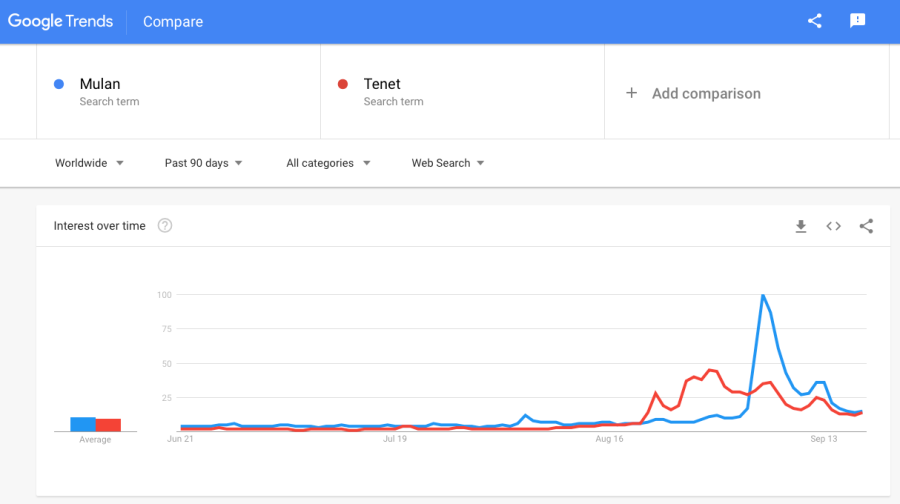
As for how demand shifts from here, we’ll see as they release on additional platforms.
Reading List
Really, this article is a continuation of this series I started in December on “Should You Release Your Film Straight to Netflix? Part I” and “Part II” In that series, I explore the economics of taking a film straight to streaming.
Previously, I built a model on how to forecast “revenue” for straight to streaming titles in this series, “The Great Irishman Project”. It’s fairly tricky to forecast streaming revenue, but definitely possible. (Netflix does it!) See my methods explained here.
I also built and explained a film finance model for feature films released traditionally, which I first explained back when I launched the site in a series evaluating the Disney-Lucasfilm acquisition.

